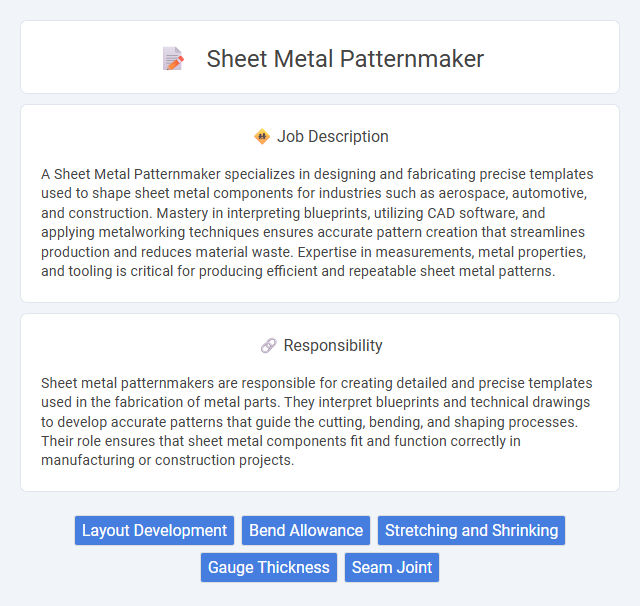
A Sheet Metal Patternmaker specializes in designing and fabricating precise templates used to shape sheet metal components for industries such as aerospace, automotive, and construction. Mastery in interpreting blueprints, utilizing CAD software, and applying metalworking techniques ensures accurate pattern creation that streamlines production and reduces material waste. Expertise in measurements, metal properties, and tooling is critical for producing efficient and repeatable sheet metal patterns.
Individuals with strong spatial awareness and precision skills are likely to be well-suited for a sheet metal patternmaker job, as the role requires detailed interpretation of technical drawings and accurate pattern creation. Those who are comfortable working in environments involving physical materials and repetitive tasks may find this occupation more suitable due to its hands-on nature. People struggling with attention to detail or preferring less physically demanding jobs might not find this position ideal for their strengths.
Qualification
A skilled sheet metal patternmaker requires expertise in reading blueprints, technical drawings, and computer-aided design (CAD) software to create accurate metal templates for fabrication. Proficiency in using tools such as plasma cutters, shears, and bending machines is essential, alongside strong problem-solving skills to develop efficient patterns for complex metal structures. Candidates typically need a background in mechanical engineering or vocational training in sheet metal technology, with hands-on experience in pattern development and metalworking techniques.
Responsibility
Sheet metal patternmakers are responsible for creating detailed and precise templates used in the fabrication of metal parts. They interpret blueprints and technical drawings to develop accurate patterns that guide the cutting, bending, and shaping processes. Their role ensures that sheet metal components fit and function correctly in manufacturing or construction projects.
Benefit
A sheet metal patternmaker is likely to benefit from specialized skills that command competitive salaries and steady job demand in manufacturing and construction industries. Opportunities for career growth and skill development are probable, given the technical nature of the work and evolving industry standards. Access to diverse projects could enhance job satisfaction and broaden professional expertise in metal fabrication and design.
Challenge
The role of a sheet metal patternmaker likely involves intricate problem-solving challenges due to the need for precise measurements and complex pattern development. It probably demands strong spatial awareness and proficiency with CAD software to translate designs into accurate templates. The complexity of materials and project specifications may require adaptability and continuous learning to overcome manufacturing obstacles.
Career Advancement
Sheet metal patternmakers with advanced CAD skills and proficiency in CNC programming unlock higher-level roles such as project lead or design engineer. Specializing in automated fabrication techniques and materials engineering significantly enhances career growth opportunities and salary potential. Continuous upskilling in 3D modeling software and lean manufacturing principles positions professionals for supervisory and management positions within manufacturing firms.
Key Terms
Layout Development
Sheet metal patternmakers specialize in layout development by creating precise flat templates from complex 3D metal parts, ensuring accurate material usage and minimal waste. They use advanced CAD software and hand tools to draft and adjust patterns, facilitating efficient fabrication and assembly processes in industries such as aerospace, automotive, and shipbuilding. Mastery in interpreting engineering drawings and applying geometric calculations is essential for optimizing flat layouts and achieving high-quality sheet metal components.
Bend Allowance
A Sheet metal patternmaker specializes in developing precise templates and layouts for cutting and bending sheet metal components. Mastery of Bend Allowance is critical in this role, as it accounts for the material stretch and deformation during bending, ensuring accurate flat patterns and minimizing waste. Accurate calculation of Bend Allowance directly impacts the final dimensions and fit of fabricated parts in industries like aerospace, automotive, and construction.
Stretching and Shrinking
A Sheet Metal Patternmaker specializing in stretching and shrinking techniques expertly manipulates metal sheets to achieve precise shapes and contours essential for fabrication. Mastery of these processes ensures minimal material waste while maintaining structural integrity and dimensional accuracy in components used across aerospace, automotive, and industrial sectors. Their role involves interpreting complex blueprints and employing hand tools or machinery to shape metal panels through controlled deformation.
Gauge Thickness
Sheet metal patternmakers specialize in creating precise patterns for metal fabrication, ensuring accurate Gauge Thickness measurements critical for durability and fit. Mastery of various gauge thicknesses, from thin 30-gauge to heavy 7-gauge, allows patternmakers to tailor designs for specific metal types and applications. Accurate gauge selection directly impacts the structural integrity and efficiency of the final sheet metal product.
Seam Joint
A Sheet Metal Patternmaker specializing in Seam Joints expertly designs and fabricates precise patterns essential for creating accurate and durable seams in sheet metal assemblies. Mastery in interpreting technical drawings and applying measurements ensures the perfect alignment and fit of seam joints, enhancing structural integrity. Advanced skills in using CAD software and traditional tools streamline the production process, improving efficiency and reducing material waste.
 kuljobs.com
kuljobs.com